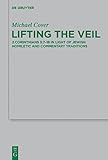Lifting the Veil : 2 Corinthians 3:7-18 in Light of Jewish Homiletic and Commentary Traditions / Michael Cover.
Material type: TextSeries: Beihefte zur Zeitschrift für die neutestamentliche Wissenschaft ; 210Publisher: Berlin ; Boston : De Gruyter, [2015]Copyright date: ©2015Description: 1 online resource (345 p.)Content type:
TextSeries: Beihefte zur Zeitschrift für die neutestamentliche Wissenschaft ; 210Publisher: Berlin ; Boston : De Gruyter, [2015]Copyright date: ©2015Description: 1 online resource (345 p.)Content type: - 9783110374315
- 9783110392739
- 9783110368963
- 227.2 23
- BS2675.52 .C69 2015
- online - DeGruyter
- Issued also in print.
| Item type | Current library | Call number | URL | Status | Notes | Barcode | |
|---|---|---|---|---|---|---|---|
 eBook
eBook
|
Biblioteca "Angelicum" Pont. Univ. S.Tommaso d'Aquino Nuvola online | online - DeGruyter (Browse shelf(Opens below)) | Online access | Not for loan (Accesso limitato) | Accesso per gli utenti autorizzati / Access for authorized users | (dgr)9783110368963 |
Browsing Biblioteca "Angelicum" Pont. Univ. S.Tommaso d'Aquino shelves, Shelving location: Nuvola online Close shelf browser (Hides shelf browser)
Frontmatter -- Preface -- Contents -- Part One: Paul’s Exegesis of Exodus 34 in Light of the Undisputed Epistles -- 1. Introduction -- 2. Patterns of Exegesis in Paul’s “Midraschartige Stücke” -- Part Two: Secondary-Level Exegesis in Hellenistic Commentaries, Homilies, and Other Exegetical Writings -- 3. Sequential Exegesis in Hellenistic Commentaries -- 4. Secondary-Level Exegesis in Homilies, Gospels, Treatises, and Greco-Roman Letters -- Part Three: Lifting the Veil: The Rhetorical Function and Theological Purpose of Paul’s Exegesis of Exodus 34 -- 5. Digressive Poetics: 2 Cor 3:7–18 as Exegetical Amplification -- 6. Lifting the Veil: 2 Cor 3:7–18 in Light of the Hellenistic Moses-Tabernacle Tradition -- References -- Index of Ancient Sources -- Index of Modern Authors -- Index of Subjects
restricted access online access with authorization star
http://purl.org/coar/access_right/c_16ec
What accounts for the seemingly atypical pattern of scriptural exegesis that Paul uses to interpret Exodus 34 in 2 Cor 3:7-18? While previous scholars have approached this question from a variety of angles, in this monograph, Michael Cover grapples particularly with the evidence of contemporaneous Jewish and Greco-Roman commentary traditions. Through comparison with Philo of Alexandria's Allegorical Commentary, the Pseudo-Philonic homilies De Jona and De Sampsone, the Anonymous Theaetetus Commentary, the Dead Sea Scrolls, Seneca's Epistulae morales, and other New Testament texts, Paul's interpretation of Exodus emerges as part of a wider commentary practice that Cover terms "secondary-level exegesis." This study also provides new analysis of the way ancient authors, including Paul, interwove commentary forms and epistolary rhetoric and offers a reconstruction of the context of Paul's conflict with rival apostles in Corinth. At root was the legacy of Moses and of the Pentateuch itself, how the scriptures ought to be read, and how Platonizing theological and anthropological traditions might be interwoven with Paul's messianic gospel.
Issued also in print.
Mode of access: Internet via World Wide Web.
In English.
Description based on online resource; title from PDF title page (publisher's Web site, viewed 28. Feb 2023)









